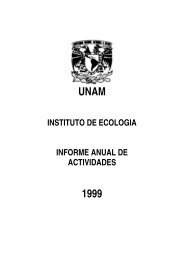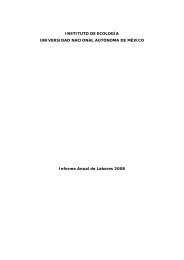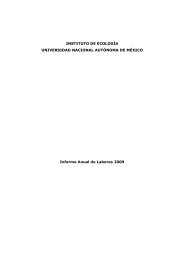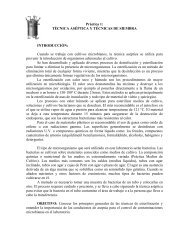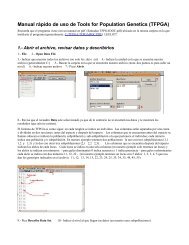July-August - Instituto de Ecología
July-August - Instituto de Ecología
July-August - Instituto de Ecología
Create successful ePaper yourself
Turn your PDF publications into a flip-book with our unique Google optimized e-Paper software.
Fig. 27.-Turbinicarpus pseudomacrochele<br />
(Fet. Antonio feyrán).<br />
ORGANO DE LA<br />
SOCIEDAD MEXICANA<br />
DE CACTOLOGIA<br />
TOMO XX N9 3<br />
Julio • Septiembre<br />
1975<br />
y SUCULENTRS MEXICRNRS
CACTACEAS y SUCULENTAS MEXICANAS.-Organo <strong>de</strong> la Sociedad Mexicana <strong>de</strong> Cactología,<br />
A. C. Director, doctor Jorge Meyrán, 2a. Juárez 42. Col. San Alvaro, México 17, D. F.<br />
Subdirector: doctor Fernando Castañón N. Comité <strong>de</strong> Revisión <strong>de</strong> Trabajos: Helia Bravo R,<br />
María Agustina Batalla, Graciela C. <strong>de</strong> Rzedowski, Rafael Martín <strong>de</strong>l Campo y Hernanrlfj<br />
Sánchez Mejorada.<br />
Esta publicación tiene como finalidad promover el estudio cientüico y <strong>de</strong>spertar el interés <strong>de</strong><br />
esta rama <strong>de</strong> la botánica. Es publicada por la Sociedad Mexicana <strong>de</strong> CactologÍa con las cuotas<br />
<strong>de</strong> los socios, sin fines lucrativos.<br />
La cuota para pertenecer a la Sociedad es <strong>de</strong> $100.00 por año. Para los socios suscriptores e,<br />
<strong>de</strong> $50.00 en la República Mexicana y <strong>de</strong> $5.00 Dlls. en el extranjero. Los socio, foráneos o <strong>de</strong>l<br />
extranjero <strong>de</strong>berán mandar giro bancario o giro postal directamente al Sr. Dudley B. Gold,<br />
Apartado Postal 979, Cuernavaca, Mor.; los <strong>de</strong> la ciudad <strong>de</strong> México al Sr. Antonio Barberena,<br />
Pernambuco 732, México 14, D. F. La revista será enviada por correo ordinario; las persona_<br />
que <strong>de</strong>seen recibirla por vía aérea <strong>de</strong>berán cubrir el porte extra.<br />
La dirección <strong>de</strong>l Secretario, Dr. Carlos Beutelspacher es: Calle 23 núm. 44, Col. San Pedro<br />
<strong>de</strong> los Pinos, México 18, D. F.<br />
TOMO XX Julio,Septiembre 1975 Núm, 3<br />
ContenIdo<br />
XX Aniversario <strong>de</strong> la }{evista .......... ................ .<br />
Las primeras relaciones <strong>de</strong> cactáceas en la Vieja Europa<br />
por H. Bravo y J. Meyrán<br />
por R Friedrich ........... .<br />
Explicación <strong>de</strong> los términos en náhuatl .... ..... ...... . por R. Martín <strong>de</strong>l Campo .. .<br />
El Valle <strong>de</strong>l Thclocactus dorado ...................... . por K. Schreier ............ .<br />
Excursión <strong>de</strong> Tomellín a Huajuapan JI ............... . por F. Otero ....... .... . . . . .<br />
Contents<br />
Pág.<br />
The first accounts of cacll ID old Europe ... "., ... , .. . by H. Friedrich ............. 63<br />
The Valley of the Gol<strong>de</strong>n Thelocactus ................ . hy K. Schreier .......... . ... 69<br />
An excursion from Tvmellin Canyon to Huajuapan <strong>de</strong><br />
Leen, Oaxaca . ... . .... . ............ . '," .... . ...... . by F. Otero . ... ............ 74<br />
Foreign Membership $5.00 U. S. Cy per year which inelu<strong>de</strong>s four number of the journal.<br />
Send it in international money or<strong>de</strong>r to Mr. Dudley B. Gold, Apartado Postal 979, Cuernavaca,<br />
Mor., although a persr-nal check in U. S. Cy is acceptable. The journal is send by regular mail<br />
unless specifically require if extra cost is cover. Life membership $100.00 U. S. Cy.<br />
Activida<strong>de</strong>s <strong>de</strong> la Sociedad durante el Segundo<br />
Trimestre <strong>de</strong> 1975<br />
En abril la seSlOn se efectuó en el domicilio <strong>de</strong> los Sres. Sánchez Mejorada, en don<strong>de</strong> fue<br />
presentado el trabajo <strong>de</strong>l Dr. Meyrán sobre Echinofossulocactus vaupelianus.<br />
En mayo se llevó al cabo una interesante excursión a Baja California, gentilmente guiada<br />
por el Dr. George Lindsay <strong>de</strong> la Aca<strong>de</strong>mia <strong>de</strong> Ciencias <strong>de</strong> California, gran co nocedor yapa,<br />
sionado <strong>de</strong> esta región; a la cual asistieron varics miembros <strong>de</strong> nuestra Sociedad, entre ellos<br />
la Sra. H. Bravo y nuestro presi<strong>de</strong>nte H. Sánchez MejGrada. Fue recorrida toda la península,<br />
<strong>de</strong>s<strong>de</strong> Tijuana hasta Cabo San Lucas. De Loreto hacia al sur, la eminente botánica Anetta<br />
Carter fue la encargada <strong>de</strong> guiar la excursión.<br />
En junio la reunión tuvo lugar en la casa <strong>de</strong>l Sr. Gold, en Cuerna vaca, dnrante la cual<br />
fue leído el interesante trabajo <strong>de</strong>l Dr. Heimo Priedrich, secretario general <strong>de</strong> la l. O. S.,<br />
titulado Primeras noticias <strong>de</strong> cactáceas en la Vieja Europa.<br />
Pág'.<br />
51<br />
53<br />
67<br />
68<br />
70
Fig. 28.- "Cirio", reproducido <strong>de</strong> la obra <strong>de</strong><br />
Gonzalo Hern.án<strong>de</strong>z <strong>de</strong> Oviedo y Valdés "His·<br />
loria General y Natural <strong>de</strong> la Indias".<br />
(1535) .<br />
Los segundos cactos en ser tratados<br />
(Cap. XXVII) son los "cardos altos é <strong>de</strong>·<br />
rechos mayores que lanzas <strong>de</strong> armas (é<br />
aun ·como picas luengas), quadrados y es·<br />
pinosos, á los quales llaman los chripstia.<br />
nos cirios, porque parecen cirios o hanchas<br />
<strong>de</strong> cera, excepto en las espinas é altura<br />
<strong>de</strong>llos". De la ilustración (Figura 28) y la<br />
'<strong>de</strong>scripción, uno no pue<strong>de</strong> <strong>de</strong>cidir a cuál<br />
género o especie se refiera en particular,<br />
pue<strong>de</strong> ser un Pilosocereus, un Stenocereus<br />
o un Lemaireocereus. Su i<strong>de</strong>ntificación<br />
como Lemaireocereus (Ritterocereus) griseus<br />
se apoya en una observación hecha<br />
54,<br />
por Oviedo <strong>de</strong> que CIEn la Tierra.Firme,<br />
en la Provincia <strong>de</strong> Nicaragua, no están es<br />
tos cardones fuera <strong>de</strong> los heredamientos<br />
<strong>de</strong> los indios. " y por esto sospecho que<br />
por mayor efecto ó por alguna especial<br />
propiedad loó conservan allá: é assí <strong>de</strong>vie.<br />
ra <strong>de</strong> ser ello aca, quando esta isla (Espa<br />
ñola) estaba poblada <strong>de</strong> indios, puesto<br />
que en los montes é arcabucos ó bosques<br />
hay muchos <strong>de</strong>stos cardones en esta isla<br />
Pero lo que agora está hecho monte, era<br />
en el tiempo passado muy habitado, adon<br />
<strong>de</strong> esta fructa é cardones se hallan". Poi<br />
lo que yo conozco, el cacto más común <strong>de</strong><br />
esta área es el griseus, y me parece que la<br />
"ilustración no es muy distinta <strong>de</strong> esta es<br />
pecie.<br />
Oviedo se preocupaba mucho sobre la<br />
utilidad <strong>de</strong> esta planta <strong>de</strong> frutos pequeños.<br />
"Lo que yo he podido compren<strong>de</strong>r en esto<br />
no es más <strong>de</strong> lo que tengo dicho, é por<br />
ventura estas fructas que á mí me parece<br />
no substancial ni <strong>de</strong> suave sabor, <strong>de</strong>be te·<br />
ner otro gusto en el paladar <strong>de</strong> los iJ:ldios.<br />
ó sería para otros efectos que no alcanzan<br />
los chripstianos hasta agora".<br />
El siguiente capítulo (XXVIII) trata<br />
sobre una Opuntia: "De los cardos <strong>de</strong> las<br />
tunas é su fructa". Oviedo nos dice que<br />
tanto la planta como el fruto son llamados<br />
"tunas" y "que también hay plantas como<br />
árboles <strong>de</strong> un aspecto muy similar, aun<br />
cuando la especie ilustrada es <strong>de</strong> una al.<br />
tura como hasta la rodilla. La mente práctica<br />
<strong>de</strong>l autor está más interesada en los<br />
frutos que en las extrañas "hojas" espino.<br />
sas, brotando una <strong>de</strong>l canto <strong>de</strong> la otra. El<br />
llama a los frutos "donosos higos largos é<br />
ver<strong>de</strong>s, é algo en partes colorado por <strong>de</strong>fuera<br />
el cuero <strong>de</strong> ellos . . . é <strong>de</strong> <strong>de</strong>ntro son<br />
colorados mucho, que tiran a rosado, lle·<br />
nos <strong>de</strong> granillos como los verda<strong>de</strong>ros higos<br />
... ". Nos dice el autor que "son <strong>de</strong><br />
buen gusto é <strong>de</strong> buena digestión". Los llama<br />
donosos porque "comiendo cinco ó seys<br />
higos <strong>de</strong>stos, es tal burla para quien nunca<br />
lo ha comido, para le poner en · mucho<br />
CACTo SUCo MEX. XX 1975
f 1 e v s 1 N DIe A.<br />
Fig. 30.-"Ficus Indica", según P. A. Mathiolus (565).<br />
Dioscori<strong>de</strong>m", un libro muy letrado y con<br />
ilustraciones realmente maravillosas. Este<br />
bot[:nico conoce y <strong>de</strong>scribe lo que en su<br />
época llamaban el "higo <strong>de</strong> indias" (Figura<br />
30). El arguye, en contra <strong>de</strong> este<br />
nombre popular, puesto que el verda<strong>de</strong>ro<br />
árhol <strong>de</strong> higo <strong>de</strong> India tal como había<br />
sido <strong>de</strong>scrito por Teofrasto, Estrabón y<br />
Plinio, es en todos sentidos, completamfmte<br />
diferente <strong>de</strong> la suculenta <strong>de</strong> las Jndias<br />
Occi<strong>de</strong>ntales. Por el contrario Mathiolus<br />
sostiene que la plan ta llamada " Opuntia"<br />
por Plinio, por crecer cerca <strong>de</strong> Opuns,<br />
India. mu y -problablemente pudiese haber<br />
sido la misma especie. Esto es, por lo que<br />
yo sé, i la <strong>de</strong>nominación original par a<br />
nuestro género Opuntia! Mathiolus relata<br />
que en esta época las Opuntias ya habían<br />
empezado a dispersarse en forma silvestre<br />
en Italia.<br />
El famoso libro <strong>de</strong> Petro Pena y Mal.·<br />
thias <strong>de</strong> L'Obel, "Nova stirpium adversaria"<br />
fue impreso en Amberes en 1576.<br />
Al igual que Mathiolus, los autores no tienen<br />
experiencia <strong>de</strong> campo, y <strong>de</strong>pen<strong>de</strong>n <strong>de</strong><br />
plantas, o fragmentos <strong>de</strong> plantas, introducidas<br />
en Europa ; pero sus <strong>de</strong>scripciones<br />
botánicas, así cemo también algunas <strong>de</strong> su<br />
ilustraciones, son irreprochables. La primera<br />
planta <strong>de</strong>scrita es una especie trepadora,<br />
quizá un Selenicereus o un Mediocactus.<br />
Los autores no vieron ni la planta<br />
viva completa, ni tampoco la flor o el fruto;<br />
por lo tanto, el <strong>de</strong>lgado tallo leño o, <strong>de</strong><br />
57
Fig. 34.-"Tepenexcomitl", <strong>de</strong> la obra <strong>de</strong> Hernán<strong>de</strong>z·Reccho·Lynceus.<br />
ilustraciones antiguas. Lo mismo se pue<strong>de</strong><br />
<strong>de</strong>cir <strong>de</strong>l "Kreuterbuch", <strong>de</strong> Adam Lonicer,<br />
impreso en 1630, un libro muy<br />
popular con ilustracion:es coloreadas a<br />
mano. Lonicer hace notar que en sus tiempos<br />
los 11igos <strong>de</strong> Indias se cultivaban por<br />
sus frutos en Europa meridional.<br />
En 1640 se publica en Alemania, con<br />
ayuda episcopal, una edición <strong>de</strong> gran lujo:<br />
el famoso "Hortus Eystettensis". En<br />
esta época, la resi<strong>de</strong>ncia episcopal <strong>de</strong><br />
Eichstadt, Baviera, tenía un famoso jardín<br />
Botánico, y para glorificar al jardín<br />
y al obispo se proyectó una ,obra <strong>de</strong> gran<br />
m3gnitud, en numerosos volúmenes foliados.<br />
El libro, como también el jardín,<br />
eran admirables. Las plantas allí cultivadas<br />
serían una honra para cualquier jardín<br />
botánico <strong>de</strong> nuestros tiempos. Aun tuvi eron<br />
éxito, como lo registra Terencio al cultivar<br />
en maceta un Melocactus con cefalio<br />
¡por más <strong>de</strong> un año!<br />
CACT. Suco MEx. XX 1975<br />
Llegamos ahora a un libro que fue publicado<br />
en Roma en 1651 : " Rerum medicarum<br />
Novae Hispaniae Thesaurus". Este<br />
es una compilación <strong>de</strong> diferentes relaciones<br />
sobre México, incluyendo la famosa<br />
"Historia plantarum ovae Hispaniae" <strong>de</strong><br />
Francisco Hernán<strong>de</strong>z, con suplementos <strong>de</strong><br />
Nardo Antonio Reccho (o Recco) y Juan<br />
Terencio Lynceo (J oanne Terentio Lynceus)<br />
. Las partes <strong>de</strong> Hernán<strong>de</strong>z son casi<br />
tan antiguas como la "Historia General"<br />
<strong>de</strong> Oviedo, pues son, <strong>de</strong> 1571. Las contribuciones<br />
<strong>de</strong> Reccho y Terencio son extremadamente<br />
interesantes por sus conocimientos<br />
<strong>de</strong> los nombres mexicanos originales<br />
<strong>de</strong> las plantas. Reccho escribió su par·<br />
te en la Ciudad <strong>de</strong> México y, evi<strong>de</strong>ntemente,<br />
en cooperació,,- con expertos en<br />
náhuatl. (N. E. )<br />
Opuntia, llamada " tuna" en las Indias<br />
Occi<strong>de</strong>ntales, en México es llamada " n octli"<br />
o "nochtli" . Los antiguos mexicanos<br />
61
en the West Indies, and it <strong>de</strong>als at sorne lenght<br />
with eacti which seemed noteworthy to the<br />
author. Noteworthy not in an abstract botanical<br />
sense, but for their eeonomic, medicinal or other<br />
practi cal value.<br />
The first cactus mentioned by Oviedo is what<br />
he calls "The thistle on which grows the fruit<br />
cal!ed Pitahaia". He <strong>de</strong>scribes it as a frUÍt as<br />
large as a fi st, crimson, with few coalesced<br />
acales, filled with a crimson juice with many<br />
seeds. The branches of the plant have four<br />
edges with grooves belween, and on the edges<br />
brown spines haH as long as a fin ger, three or<br />
four at a time. He cIoses lhe <strong>de</strong>scription with<br />
lhe advice : Who wants to pick a Pitahaia where<br />
it grows mustn't hurry bul act with care, for<br />
these pricking thistles are compact and inter·<br />
laced and wel! armed. Of course we try W<br />
guess what this Pitahaia may have been. Probab·<br />
Iy it was Acanthocereus tetragonus or some similar<br />
species.<br />
The second trealed are lhe "high thistles,<br />
straight like long lances, angular and spiny,<br />
called Cirio by the Christians, because they<br />
resemble candles or wax torcbes'.' From the<br />
picture (fig. 28 ) and the <strong>de</strong>scription one cannet<br />
<strong>de</strong>ci<strong>de</strong> what genus or species was especially<br />
meant, 1t could be a Pilosocereus, Stenocereus<br />
or Lemaireocereus. The i<strong>de</strong>ntificalion as Lemaireocereus<br />
(Ritterocereus) griseus is supported<br />
by an observation ma<strong>de</strong> by Oviedo, tbat these<br />
"Cirios" were planted by the Indians of the<br />
mainland around their settlements, and tbat in<br />
the islands the occurrence of such planto indicated<br />
always an abandoned indian village. As<br />
far as I know, Ihe most usual fence cactus in<br />
this area is the "Griseus", and I think the<br />
piclure is not so unlike thi species. Señor<br />
Oviedo worried much about the usefulness of<br />
this plant with small fruits: "Have the indians<br />
another sense of -taste or do they grow Ihe<br />
plant for a use the Christi ans have not yet<br />
found out?".<br />
The next chapter <strong>de</strong>als with an Opuntia: "On<br />
the thistle of Tunas and their fruits". Oviedo<br />
states that Ihe plant as well as the fmit are<br />
cal!ed Tuna, and that there are also tree-like<br />
planls of a very similar appearance, though the<br />
figured species is about knee-high. The practical<br />
mind of the author is much more interested in<br />
the fruits Ihan in the strange thorny "lea ves",<br />
ene co ming out of the edge of anolher. He<br />
calls Ihe fruits "<strong>de</strong>lightful figs", on the outsi<strong>de</strong><br />
green wilh a reddish tint, the pulp <strong>de</strong>ep red and<br />
fuH of kernels. The Tunas are savoury and<br />
whclescme, the author say"', but they are a<br />
"jocese food". The joke is that whoever ea ts<br />
for the {irst time 5 or 6 of Ihese fi gs will pass<br />
umine <strong>de</strong>ep red like blood, and he will think<br />
that "al! veins are broken in his bl(ld<strong>de</strong>r", and<br />
64<br />
run for his life to the next doctor. This must<br />
have been a very co=on practical joke with<br />
newcomers, for we read this story again and<br />
again in Ihe books of these oId times.<br />
Finally and in a separate chapter concerning<br />
medicinal plants we find the <strong>de</strong>scription of<br />
"The Iree or plant with which fractures are<br />
¡:ured" (fig. 29). It is obviously a tree-like<br />
Opuntia - or would you cal! it a Consolea? -<br />
and it is said to accure both in the mainland<br />
and in the islands, and not at al! arare species.<br />
The author calls it a fi erce and ugly plant,<br />
" th e monster of tree-kind". The stem and the<br />
branches are brown, the young and terminal<br />
leaves al'e green and very spiny, as are Ihe<br />
Lranches and the tmnk. The medicinal use is<br />
interestillg: The indians remove the spines and<br />
clUsh or mince the lea ves and put the mash<br />
en a linen patch {or a poultice. This is put<br />
around the fractured limb and becomes a ti ght<br />
clinging dressing that cannot be <strong>de</strong>taehed from<br />
the skin befo re tbe complete healing of the<br />
fracture, bu t as soon as the bones are grown<br />
tegcther the dressing peels off spontaneously.<br />
I dare say that tbis sOllnds promising enou gh,<br />
maybe better than a pI aster dressing. OI these<br />
iraeture-healing Opuntias Señor Oviedo has to<br />
repcrt one more illteresting use: The indians<br />
make out of lhe olive.sized fruits a paste, cut<br />
it in Ihin pieces as large as a fingernail, and<br />
seU it packed up in colton. "And this is highly<br />
esteemed arti<strong>de</strong>" he writes "for indians and<br />
thei r women to paint themselves, for it is fine<br />
cm'mine cclour tending to pink. It is also the<br />
best rouge for our ladies in Spain and Italy<br />
or elsewhere, to beautify or rather to make a<br />
meS'S of the appearanee which Cod has given<br />
them". It is evi<strong>de</strong>nt that Oviedo speaks here<br />
of the genuine carmine which is a reality not<br />
a produce of th e fruits but of the cochineal<br />
scalc-insect.<br />
I have <strong>de</strong>alt at some Ienght with this <strong>de</strong>scripticn<br />
of Ihe West Indies, because \Ve have<br />
here in fact the first authentic account of cacti<br />
in Europe, The drawings are not so bad, save<br />
ior th e Pitahaia which may have been sketched<br />
Irom memory.<br />
Scme years later, 1565, P. A. Mathiolus published<br />
his "Commentarii in Dioscori<strong>de</strong>m!', a<br />
highly learned book with really marvellous' illustrations,<br />
This botanist knows and <strong>de</strong>scribes<br />
what was then called the "India n fi g" (fig. 30),<br />
He argues against this popular name, for the<br />
true Indian fig-tree, as Theophrastus, Strabo<br />
and Plinius had <strong>de</strong>scribed it, is in every respect<br />
entirely different from th e West India ns succulent.<br />
On the contrary, MathiclllS holds to be<br />
very probable that the plant which was cal!ed<br />
"Opuntia" by Plinius, since it grew near Opuns<br />
in India, may have been the same species. This<br />
CACTo SUCo MEX. XX 1975
Fig.36.-"Cactus repens subquinque angulari," y "Cactus repens trigonus"<br />
<strong>de</strong> la ohra <strong>de</strong> Charles Plumier (circa 1700).<br />
is, as far as 1 know, the original name-giving<br />
for our genus Opuntia! Mathiolus states that at<br />
this time Opuntias have already begun to run<br />
wild in Italy. . '_ I L.,I "-<br />
The famous bcok of P. Pena and M. <strong>de</strong> Lobel<br />
"Nova stirpium adversaria" was priuted 1576 at<br />
Antwerp. Like Mlathiolus, the authors have no<br />
habitat experience but <strong>de</strong>pend on plants or pans<br />
or plants brcught to Europe. But their botanical<br />
<strong>de</strong>scripticns and serne of their pietures are<br />
blameles,. The fi rst plant <strong>de</strong>scribed is probable<br />
a climbing species, maybe a Selenicereu s or<br />
Mediocactus. The authors have not seen the<br />
whcle living plant nor the flower or the fruit,<br />
and so the thin woody stem with a blackis'h<br />
bark and crenate ribs with littIe starlike spine,<br />
is net very eharacteristic. The next drawing<br />
shcws us an upright basally branched Cereus,<br />
a little schematized and geometrical. The <strong>de</strong>scription<br />
(in the Latin d these time, that is<br />
not easy to un<strong>de</strong>rstand) proves that the authors<br />
have enly seen this single sterile specimen. For<br />
flowers and fruits they quote the supplier oí<br />
the plant" who cornpared the belLshaped red<br />
flower with a foxglove (Digitalis purpurea).<br />
For want cf information about the provenaltce<br />
we have no clue fol' i<strong>de</strong>ntifying the spec:es.<br />
It may have been a Trichocereus or Cereus 'in<br />
rhe mo<strong>de</strong>rn sen se, but hardly C. peruvianus,<br />
althcugh sorne subS'equent herbals have the same<br />
picture in conneclion with this name "Cereus<br />
peruvianus". Amusing is the rapture with which<br />
the <strong>de</strong>scription is introduced: "pene portentosa<br />
CACTo SUCo MEX. XX 1975<br />
elegantia" (almost supernatural elegance) and<br />
"admirable S'pectacle of beauty which fills the<br />
mind and the eyes of the yiewer" characterize<br />
the impression these never befo re S'een piants<br />
ma<strong>de</strong> on early botanists. '<br />
But even more <strong>de</strong>lighted are Pena and Lobel<br />
by th e plant they caU "Echinomelocactos sive<br />
Meloc,lrduus echinatus Indiae occiduae" (Fig.<br />
31): '"tle who is not in,pired by this won<strong>de</strong>r<br />
d be::u ty and strangeness to contemplate the<br />
skilful epulence cf nature, is certainly not<br />
gifted with a refined philosophical feeling".<br />
'fhe :leat and accurate illustration shows a<br />
Melocactus which may be Melocactus lobelii<br />
Suringar, in BRITTON & ROSE within the Cactus<br />
macracanthus complexo The name "Echinomelocactus"<br />
as well as "Melocarduus arose, at<br />
the author says, from the impression that this<br />
plant is ccmpesed of a melon or pumpkin and<br />
a thistle (Cardus). The name "cactus", here for<br />
the first time connected with a cactaceous plant,<br />
is an ancient greek name for a thistle in Sicily,<br />
mentioned by Theophrastus more than 2000 years<br />
ago, possibly the wild artichoke .1 ernphasize<br />
lhis ethymological <strong>de</strong>rivation to refute the wi<strong>de</strong>spread<br />
epinion that 'cactus" is an original general<br />
term for Cactaceae. This name is in this<br />
sen5e in truth mucb younger rhan Cereus, Opuntia<br />
and Melocactus.<br />
Twelve years aIter P ena and Lobel's book a<br />
volumine:us Gennan herbal carne out, the "Kriiuterbuch"<br />
of Thecdorus Tahernaemontanus. It<br />
is a popular compilat¡on cf medical plants,<br />
65







